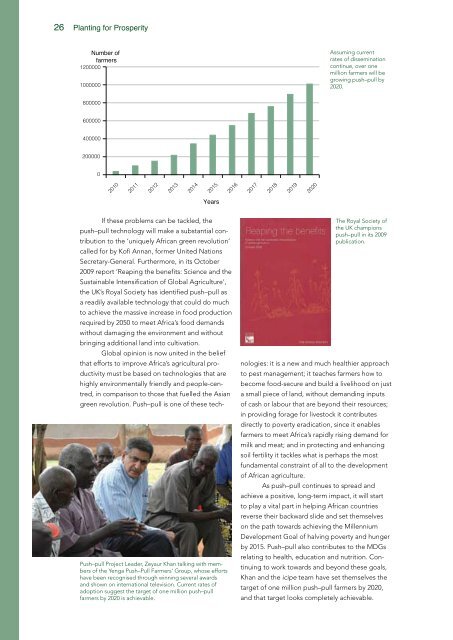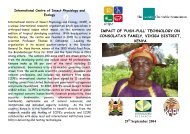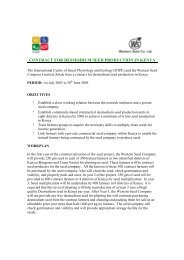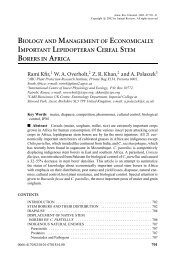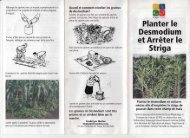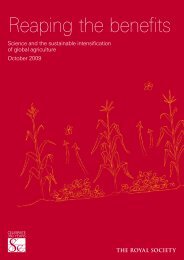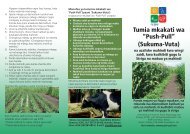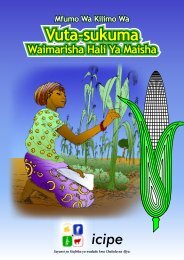a model for Africa's green revolution - Push-Pull
a model for Africa's green revolution - Push-Pull
a model for Africa's green revolution - Push-Pull
Create successful ePaper yourself
Turn your PDF publications into a flip-book with our unique Google optimized e-Paper software.
26 Planting <strong>for</strong> Prosperity<br />
Number of<br />
farmers<br />
1200000<br />
1000000<br />
Assuming current<br />
rates of dissemination<br />
continue, over one<br />
million farmers will be<br />
growing push–pull by<br />
2020.<br />
800000<br />
600000<br />
400000<br />
200000<br />
0<br />
2010<br />
2011<br />
2012<br />
2013<br />
2014<br />
2015<br />
2016<br />
2017<br />
2018<br />
2019<br />
2020<br />
Years<br />
If these problems can be tackled, the<br />
<strong>Push</strong>–pull Project Leader, Zeyaur Khan talking with members<br />
of the Yenga <strong>Push</strong>–<strong>Pull</strong> Farmers’ Group, whose ef<strong>for</strong>ts<br />
have been recognised through winning several awards<br />
and shown on international television. Current rates of<br />
adoption suggest the target of one million push–pull<br />
farmers by 2020 is achievable.<br />
The Royal Society of<br />
the UK champions<br />
push–pull in its 2009<br />
publication.<br />
push–pull technology will make a substantial contribution<br />
to the ‘uniquely African <strong>green</strong> <strong>revolution</strong>’<br />
called <strong>for</strong> by Kofi Annan, <strong>for</strong>mer United Nations<br />
Secretary-General. Furthermore, in its October<br />
2009 report ‘Reaping the benefits: Science and the<br />
Sustainable Intensification of Global Agriculture’,<br />
the UK’s Royal Society has identified push–pull as<br />
a readily available technology that could do much<br />
to achieve the massive increase in food production<br />
required by 2050 to meet Africa’s food demands<br />
without damaging the environment and without<br />
bringing additional land into cultivation.<br />
Global opinion is now united in the belief<br />
that ef<strong>for</strong>ts to improve Africa’s agricultural productivity<br />
must be based on technologies that are<br />
highly environmentally friendly and people-centred,<br />
in comparison to those that fuelled the Asian<br />
<strong>green</strong> <strong>revolution</strong>. <strong>Push</strong>–pull is one of these technologies:<br />
it is a new and much healthier approach<br />
to pest management; it teaches farmers how to<br />
become food-secure and build a livelihood on just<br />
a small piece of land, without demanding inputs<br />
of cash or labour that are beyond their resources;<br />
in providing <strong>for</strong>age <strong>for</strong> livestock it contributes<br />
directly to poverty eradication, since it enables<br />
farmers to meet Africa’s rapidly rising demand <strong>for</strong><br />
milk and meat; and in protecting and enhancing<br />
soil fertility it tackles what is perhaps the most<br />
fundamental constraint of all to the development<br />
of African agriculture.<br />
As push–pull continues to spread and<br />
achieve a positive, long-term impact, it will start<br />
to play a vital part in helping African countries<br />
reverse their backward slide and set themselves<br />
on the path towards achieving the Millennium<br />
Development Goal of halving poverty and hunger<br />
by 2015. <strong>Push</strong>–pull also contributes to the MDGs<br />
relating to health, education and nutrition. Continuing<br />
to work towards and beyond these goals,<br />
Khan and the icipe team have set themselves the<br />
target of one million push–pull farmers by 2020,<br />
and that target looks completely achievable.


